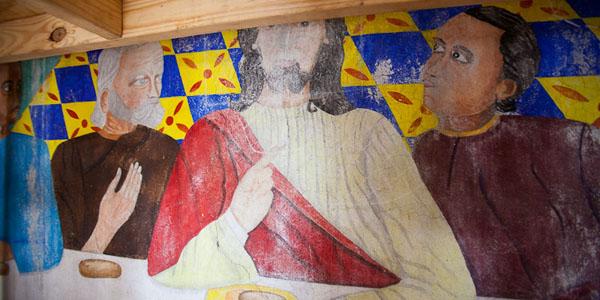Haiti’s Art in Peril
A mural of Jesus at the site of the collapsed Holy Trinity Cathedral, Haiti. (Photo: Jake Warga)
When, even a year after a devastating earthquake, first priorities are still basic needs like food, water and housing, what happens to the rich culture of the island? Can the art be saved too?
The present in Port-au-Prince is very loud: traffic jams of dirty cars, slopping water trucks, clean NGO SUVs, people selling and yelling. All this is happening just outside the church I'm standing in. Actually, I shouldn't say "in." The church is gone, just pieces of some walls remain, which are now covered in scaffolding.
"We're now on site of the collapsed Holy Trinity Cathedral, which suffered massive damage, entire naïve collapsed," Stephanie Hornbeck said.
Hornbeck is an art conservator working with the Haitian Cultural Recovery Project, in partnership with the Smithsonian. He is here to remove and preserve murals that were once inside the church, but are now exposed to the elements. From an original 14, only three survived.
Created in the 50s, the murals were created by Haitian artists, who painted the biblical scenes.
"[It is] considered very innovative because they chose Haitian artists to depict the new testament and the scenes have Haitians in them so it's telling the story of the new testament, but through a contemporary lens," Hornbeck said.
So the last supper, one of the paintings that survived, has Haitians sitting at the table, and the baptism of Christ has some Haitians doing laundry in the water next to the river.
We looked closer into the stone face of Jesus, who is painted white, not Haitian. There is significant water damage to the face, as evident in the form of white salts.
So why work to save the cultural past when there is still so much suffering in the present? When hundreds of thousands still live in tent camps and have limited access to basic services like sanitation and water?
Olsen Jean-Jilian is the Project Manager for Haiti's Cultural Recovery Project.
"It's very important to give water to people and give food to them, but you can not help them to rebuild a country without education, without understanding the culture," Jean-Jilian said.
"The past is very important to understand so you can see where you're going. If we try to save cultural materials from the past we can better resolve the problems we're going to face in the future. That's our hope. So preserving culture is a means to better approach; the reconstruction process."
Art is one way that is actually helping Haiti recover.
Toni Monnin runs a high-end gallery in the wealthier Petionville area of Port-au-Prince.
"Art, in any form, is an integral part of life in Haiti. So if you don't preserve that, then I believe you've taken a chunk out of this society, this culture. Art is the lifeblood of the country," she said.
While there was vast structural damage, Haiti's vibrant art scene was only slightly wounded in the earthquake.
"That was the longest 35 seconds of everybody's life here in Haiti," Monnin said.
"The earthquake was on a Tuesday and we opened the gallery on Saturday because we knew they'd need help. We're very lucky that most of them, all of them were alive; all the artists we work with. But everyone of them lost family members and almost everyone lost his home because they lived down near the epicenter."
As I was gazing at the expensive art, wondering who actually buys it, an aid worker from Save the Children came in, hurriedly on her way out of the country, and dropped $2,000 on 3 small fabric pieces, apparently a tiny addition to her collection back in Washington D.C. "I don't have kids," she said, "so I collect art."
I still worry how people survive in Haiti, the poverty, the suffering, but I no longer worry about their culture, their art surviving.
"All Haitians are artists, they are just an entire nation of artists," Monnin said.
UPDATED: A previous version of this story incorrectly spelled Toni Monnin's name. Thanks to our listeners for helping correct this error.
